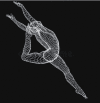Research on Human Sports Rehabilitation Design Based on Object-Oriented Technology
- PMID: 34257852
- PMCID: PMC8260321
- DOI: 10.1155/2021/6626957
Research on Human Sports Rehabilitation Design Based on Object-Oriented Technology
Abstract
In order to improve the effect of human motion rehabilitation, a design model of human motion rehabilitation based on object-oriented technology is proposed. The entire model design process includes the following steps. First, a visual dynamic tracking model for human motion rehabilitation is established, and then a fuzzy PID (Proportion Integration Differentiation) superheterodyne control method is used to design the bone training control for human motion rehabilitation. The bone tracking control and adaptive training are under the control of object-oriented technology; it is analyzed by collecting human activity data during training. The 6-DOF kinematics problem of human movement rehabilitation is decomposed into the bone training control problem in the subspace. Combining object-oriented technology, visual blur recognition of human sports rehabilitation training, and adopting an adaptive kinematics model to design sports rehabilitation can improve the control convergence and global stability of the human sports rehabilitation process. The simulation results show that the method has a good overall steady state and the sports rehabilitation training effect is obvious.
Copyright © 2021 Dandan Cao et al.
Conflict of interest statement
The authors declare that they have no conflicts of interest.
Figures








References
-
- Hou C., Wang Z., Zhazo Y., Song G. Load adaptive force-free control for the direct teaching of robots. ROBOT. 2017;39(4):439–448.
-
- You Y., Zhang Y., Li C. G. Force-free control for the direct teaching of robots. Journal of Mechanical Engineering. 2014;50(3):10–17. doi: 10.3901/jme.2014.03.010. - DOI
-
- Uijlings J. R. R., van de Sande K. E. A., Gevers T., Smeulders A. W. M. Selective search for object recognition. International Journal of Computer Vision. 2013;104(2):154–171. doi: 10.1007/s11263-013-0620-5. - DOI
-
- Zhang D., Li B., Wang L. Tracking control method of the centre-of-mass velocity for a Snake-like robot based on the continuum model. ROBOT. 2017;39(6):829–837.
-
- Li K., Jie M. I. Research on mechanical and electrical control algorithm of bionic robot based on variable structure PID. Journal of Henan University of Engineering (Natural Science Edition) 2016;28(2):32–37.
Publication types
MeSH terms
LinkOut - more resources
Full Text Sources

